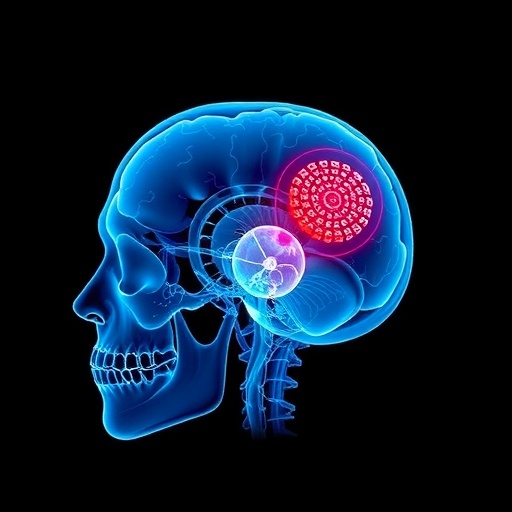In a groundbreaking advancement poised to revolutionize neurosurgical practice, scientists and biomedical engineers from Central South University and MedArt Technology Co., Ltd. in China have collaboratively developed a fully biodegradable cranial fixation device. This new innovation tackles the persistent challenges neurosurgeons face when closing skulls after surgeries, particularly those related to the limitations of current fixation devices that rely on metallic or semi-absorbable polymers. Unlike traditional titanium-based systems that frequently cause imaging artifacts or remain permanently lodged in patients, this novel device offers a solution that bolsters bone healing, drastically reduces complications, and ultimately vanishes as the skull regenerates.
The conventional cranial fixation methods, historically dominated by titanium plates and screws, pose significant drawbacks. Metal implants interfere with crucial postoperative brain imaging techniques such as CT and MRI, creating artifacts that obscure diagnostic clarity. Moreover, metallic devices remain indefinitely, sometimes inciting long-term discomfort or necessitating secondary removal surgeries. Semi-absorbable polymers, frequently employed to address some of these issues, often degrade inconsistently, leading to unpredictable local reactions and impaired healing. Recognizing these troubling limitations, the research team sought a device that not only secures the cranial bone flap firmly but also harmonizes completely with the natural regenerative processes of the skull.
Leveraging the biocompatible and biodegradable properties of high-purity poly-L-lactic acid (PLLA), the researchers engineered a cranial fixation system capable of full absorption over time, precisely matching the rate of natural bone healing. The choice of PLLA was strategic, given its proven compatibility in orthopedic and maxillofacial applications, its mechanical strength, and its predictable hydrolytic degradation into non-toxic lactic acid. This meticulous material selection ensures that the device maintains sufficient fixation strength during the critical early postoperative period without eliciting harmful tissue responses as it gradually dissolves.
Comparative laboratory studies pitted this PLLA-based device against the industry-standard Aesculap® CranioFix system, elucidating remarkable performance differentials. Mechanical testing revealed that the MedArt device retained its fixation strength for approximately twice as long as its metallic semi-absorbable counterpart. This prolonged mechanical integrity during the vital weeks following surgery mitigates risks of bone flap displacement. Equally compelling was the device’s gradual degradation profile that avoided sudden spikes in lactic acid concentration, which can provoke inflammatory reactions and compromise healing efficacy. The controlled resorption spanned over 14 days in vitro, contrasting sharply with control devices that began rapid degradation within a week.
Transitioning from bench to bedside, a robust multicenter clinical trial encompassing 90 adult patients across four major Chinese hospitals was conducted to validate these promising in vitro outcomes. Patients receiving the new PLLA fixation system exhibited consistently narrower bone gaps—averaging only 0.58 millimeters—when assessed by advanced 3D CT reconstruction, compared to the 0.80 millimeters observed in patients treated with CranioFix devices. This subtle yet significant difference signals superior accuracy and stability in skull flap repositioning. Notably, no device-related postoperative complications, including infections or inflammatory responses, were documented in the PLLA group, underscoring its exceptional biocompatibility and safety.
The success of this device also hinged on its surgeon-friendly design. Its threaded connecting rods and adjustable locking discs empower surgeons to reposition or fine-tune fixation intraoperatively, enhancing precision and reducing operative time. This flexibility is particularly critical in adapting to individual skull curvatures and variabilities, distributing mechanical forces evenly across fixation points and mitigating stress concentrations that can impair healing. Such ergonomic engineering bolsters surgical outcomes while minimizing trauma to periosteal and dural tissues adjacent to the bone flap.
This fully absorbable fixation system holds particular promise for vulnerable populations, such as pediatric patients and individuals experiencing cranial trauma, where minimizing foreign bodies and optimizing natural healing processes are paramount. Although the current clinical trial focused exclusively on adult patients aged 18 to 70 years, future investigations are planned to evaluate pediatric applications, where traditional metal implants often carry increased risks and limitations. The prospect of eliminating permanent cranial hardware, especially in growing children, marks a transformative potential in neurosurgical care.
Beyond the direct clinical advantages, this innovation aligns with broader movements in regenerative medicine and biomedical engineering aimed at developing bioresorbable implants that integrate seamlessly with human physiology. By eliminating the need for secondary surgeries to remove hardware and reducing chronic foreign body responses, such devices improve patient quality of life and reduce healthcare system burdens. The slow, steady degradation profile of PLLA not only secures mechanical integrity during critical healing phases but also fosters an environment conducive to natural bone regeneration—an elegant synergy between science and nature.
Dr. Siyi Wanggou, leading the neurosurgery department at Xiangya Hospital, Central South University, emphasizes that this development represents a paradigm shift: “Our goal was to create a device that’s strong, safe, and leaves nothing behind.” This statement reflects a forward-thinking approach in medical device innovation, moving away from static, permanent hardware towards dynamic, responsive support systems that align with biological processes. The MedArt fixation system’s achievement of 100% success in maintaining cranial flap position without complications validates this strategic direction.
Throughout the clinical trial, no significant inflammatory or immune responses were observed with the PLLA device, in stark contrast to minor incision healing issues in the metallic CranioFix group. Comprehensive postoperative evaluations—including blood panels and imaging—confirmed the device’s superior biocompatibility, reducing concerns of foreign body reactions that can jeopardize patient recovery. This improved compatibility not only benefits patient outcomes but also opens avenues for integrating such devices with emerging biologics or growth factors to further accelerate osteogenesis.
The collaboration between Central South University’s neurosurgery experts and MedArt Technology exemplifies the power of multidisciplinary partnerships in translating biomedical engineering breakthroughs into clinical realities. This coalescence of clinical insight and materials science propelled the design of a device that meets the stringent demands of neurosurgery while addressing unmet clinical needs. The team’s commitment to rigorous randomized controlled trials further strengthens the evidence base supporting this technology’s adoption.
As global neurosurgical communities continually seek methods to optimize patient safety and recovery, fully absorbable cranial fixation systems stand at the forefront of innovation. The promising results from this comparative study offer a blueprint for future device development that emphasizes biodegradability, mechanical reliability, and surgical adaptability. With ongoing research and expansion into pediatric and traumatic injury settings, such devices may soon become a new standard of care, embodying the harmony between cutting-edge science and compassionate medicine.
In sum, this novel PLLA-based cranial fixation system embodies a significant leap forward in skull surgery technology. It ensures robust mechanical support during critical healing phases, seamlessly degrades congruent with natural bone regeneration, and virtually eliminates postoperative complications associated with permanent implants. This innovation represents a milestone in neurosurgical biomaterials, heralding a safer, more patient-centered future in cranial surgery.
Subject of Research: Neurosurgery, Biomedical Engineering, Clinical Neuroscience
Article Title: A comparative study of a novel absorbable cranial flap fixation system and Aesculap CranioFix
News Publication Date: September 13, 2025
References: DOI: 10.1186/s41016-025-00406-6
Image Credits: Dr. Siyi Wanggou, Central South University, China
Keywords: Neurosurgery, Biomedical engineering, Medical technology, Biomaterials, Surgery, Regenerative medicine, Clinical research, Neuroscience, Tissue engineering, Skull
Tags: absorbable skull devicebiodegradable cranial fixation devicebiodegradable medical devicesCentral South University researchchallenges in cranial closurecranial surgery advancementsimaging artifacts in neurosurgeryMedArt Technology collaborationneurosurgical innovationpostoperative healing solutionsregenerative medicine in neurosurgerytitanium-based fixation drawbacks





